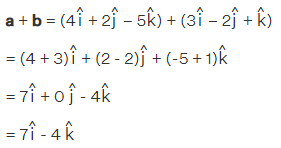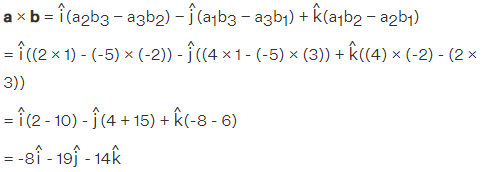Vectors Chapter Notes | Mathematics for Grade 10 PDF Download
Introduction
Vectors are geometrical entities that have magnitude and direction. A vector can be represented by a line with an arrow pointing towards its direction and its length represents the magnitude of the vector. Therefore, vectors are represented by arrows, they have initial points and terminal points. The concept of vectors was evolved over a period of 200 years. Vectors are used to represent physical quantities such as displacement, velocity, acceleration, etc.
Further, the use of vectors started in the late 19th century with the advent of the field of electromagnetic induction. Here, we will study the definition of vectors along with properties of vectors, formulas of vectors, operation of vectors along using solved examples for a better understanding.
What are Vectors?
A vector is a Latin word that means carrier. Vectors carry a point A to point B. The length of the line between the two points A and B is called the magnitude of the vector and the direction of the displacement of point A to point B is called the direction of the vector AB. Vectors are also called Euclidean vectors or Spatial vectors. Vectors have many applications in maths, physics, engineering, and various other fields.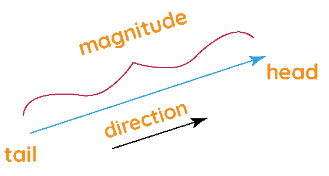
Vectors in Euclidean Geometry- Definition
Vectors in math is a geometric entity that has both magnitude and direction. Vectors have an initial point at the point where they start and a terminal point that tells the final position of the point. Various operations can be applied to vectors such as addition, subtraction, and multiplication. We will study the operations on vectors in detail in this article.
Vectors - Examples
Vectors play an important role in physics. For example, velocity, displacement, acceleration, force are all vector quantities that have a magnitude as well as a direction.
Representation of Vectors
Vectors are usually represented in bold lowercase such as a or using an arrow over the letter as Vectors can also be denoted by their initial and terminal points with an arrow above them, for example, vector AB can be denoted as
Vectors can also be denoted by their initial and terminal points with an arrow above them, for example, vector AB can be denoted as  The standard form of representation of a vector is
The standard form of representation of a vector is  Here, a,b,c are real numbers and
Here, a,b,c are real numbers and  are the unit vectors along the x-axis, y-axis, and z-axis respectively.
are the unit vectors along the x-axis, y-axis, and z-axis respectively. The initial point of a vector is also called the tail whereas the terminal point is called the head. Vectors describe the movement of an object from one place to another. In the cartesian coordinate system, vectors can be denoted by ordered pairs. Similarly, vectors in 'n' dimensions can be denoted by an 'n' tuple. Vectors are also identified with a tuple of components which are the scalar coefficients for a set of basis vectors. The basis vectors are denoted as: e1 = (1,0,0), e2 = (0,1,0), e3 = (0,0,1)
The initial point of a vector is also called the tail whereas the terminal point is called the head. Vectors describe the movement of an object from one place to another. In the cartesian coordinate system, vectors can be denoted by ordered pairs. Similarly, vectors in 'n' dimensions can be denoted by an 'n' tuple. Vectors are also identified with a tuple of components which are the scalar coefficients for a set of basis vectors. The basis vectors are denoted as: e1 = (1,0,0), e2 = (0,1,0), e3 = (0,0,1)
Magnitude of Vectors
The magnitude of a vector can be calculated by taking the square root of the sum of the squares of its components. If (x,y,z) are the components of a vector A, then the magnitude formula of A is given by,
|A| = √(x2+y2+z2)
The magnitude of a vector is a scalar value.
Angle Between Two Vectors
The angle between two vectors can be calculated using the dot product formula. Let us consider two vectors a and b and the angle between them to be θ. Then, the dot product of two vectors is given by a·b = |a||b| cosθ. We need to determine the value of the angle θ. The angle between two vectors also indicates the directions of the two vectors. θ can be evaluated using the following formula:
θ = cos-1[(a·b)/|a||b|]
 |
Test: Scalars and Vectors
|
Start Test |
Types of Vectors
The vectors are termed as different types based on their magnitude, direction, and their relationship with other vectors. Let us explore a few types of vectors and their properties:
- Zero Vectors
Vectors that have 0 magnitude are called zero vectors, denoted by = (0,0,0). The zero vector has zero magnitudes and no direction. It is also called the additive identity of vectors.
= (0,0,0). The zero vector has zero magnitudes and no direction. It is also called the additive identity of vectors. - Unit Vectors
Vectors that have magnitude equals to 1 are called unit vectors, denoted by It is also called the multiplicative identity of vectors. The magnitude of a unit vectors is 1. It is generally used to denote the direction of a vector.
It is also called the multiplicative identity of vectors. The magnitude of a unit vectors is 1. It is generally used to denote the direction of a vector. - Position Vectors
Position vectors are used to determine the position and direction of movement of the vectors in a three-dimensional space. The magnitude and direction of position vectors can be changed relative to other bodies. It is also called the location vector. - Equal Vectors
Two or more vectors are said to be equal if their corresponding components are equal. Equal vectors have the same magnitude as well as direction. They may have different initial and terminal points but the magnitude and direction must be equal. - Negative Vector
A vector is said to be the negative of another vector if they have the same magnitudes but opposite directions. If vectors A and B have equal magnitude but opposite directions, then vector A is said to be the negative of vector B or vice versa. - Parallel Vectors
Two or more vectors are said to be parallel vectors if they have the same direction but not necessarily the same magnitude. The angles of the direction of parallel vectors differ by zero degrees. The vectors whose angle of direction differs by 180 degrees are called antiparallel vectors, that is, antiparallel vectors have opposite directions. - Orthogonal Vectors
Two or more vectors in space are said to be orthogonal if the angle between them is 90 degrees. In other words, the dot product of orthogonal vectors is always 0. a·b = |a|·|b|cos90° = 0. - Co-initial Vectors
Vectors that have the same initial point are called co-initial vectors.
Vectors Formulas
Different mathematical operations can be applied to vectors such as addition, subtraction, and multiplication. In this section, we will explore the vector formulas for vector addition, subtraction, dot-product, cross-product and angle between the vectors.
The list of vectors formulas that we will be studying in detail further is as follows: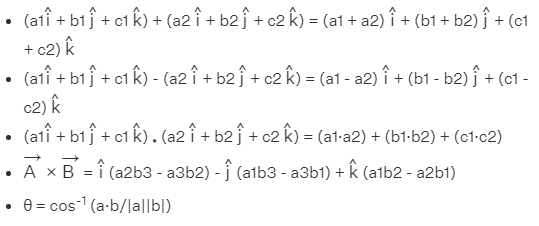
Properties of Vectors
The following properties of vectors help in better understanding of vectors and are useful in performing numerous arithmetic operations involving vectors.
- The addition of vectors is commutative and associative.
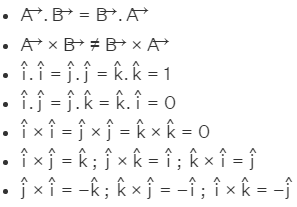
- The dot product of two vectors is a scalar and lies in the plane of the two vectors.
- The cross product of two vectors is a vector, which is perpendicular to the plane containing these two vectors.
Operations on Vectors
Some basic operations on vectors can be performed geometrically without taking any coordinate system as a reference. These vector operations are given as addition, subtraction, and multiplication by a scalar. Also, there are two different ways to multiply two vectors together, the dot product and the cross product. These are briefly explained as given below,
- Addition of Vectors
- Subtraction of Vectors
- Scalar Multiplication
- Scalar Triple Product of Vectors
- Multiplication of Vectors
Addition of Vectors
Adding vectors is similar to adding scalars. The individual components of the respective vectors are added to get the final value:
a + b =  = (a1, b1, c1) + (a2, b2, c2) = (a1 + a2, b1 + b2, c1 + c2) = (a1 + a2)
= (a1, b1, c1) + (a2, b2, c2) = (a1 + a2, b1 + b2, c1 + c2) = (a1 + a2) 
Triangle Law of Addition of Vectors: The law states that if two sides of a triangle represent the two vectors (both in magnitude and direction) acting simultaneously on a body in the same order, then the third side of the triangle represents the resultant vector.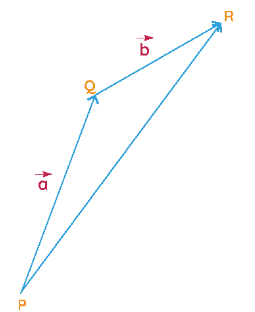
Parallelogram Law of Addition of Vectors: The law states that if two co-initial vectors acting simultaneously are represented by the two adjacent sides of a parallelogram, then the diagonal of the parallelogram represents the sum of the two vectors, that is, the resultant vector starting from the same initial point.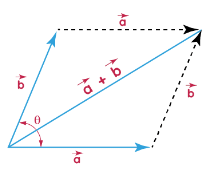
Subtraction of Vectors
The subtraction of vectors is similar to the addition of vectors. But here only the sign of one of the vectors is changed in direction and added to the other vector.
Scalar Multiplication of Vectors
A scalar is a real number that has no direction. When a scalar is multiplied by a vector, we multiply the scalar by each component of the vector. The operation of multiplying a vector by a scalar is called scalar multiplication. When a vector a = (a1, a2, a3) =  is multiplied by a scalar r, the resultant vector is:
is multiplied by a scalar r, the resultant vector is:
ra = (ra1, ra2, ra3) = (ra1)e1 + (ra2)e2 + (ra3)e3
- If r is negative, then the direction of the resultant vector changes direction by 180 degrees.
- Scalar multiplication is distributive over vector addition, that is, r(a+b) = ra + rb
The multiplication of vectors with any scalar quantity is defined as 'scaling'. Scaling in vectors only alters the magnitude and does not affect the direction. Some properties of scalar multiplication in vectors are given as,
- k(a + b) = ka + kb
- (k + l)a = ka + la
- a·1 = a
- a·0 = 0
- a·(-1) = -a
Scalar Triple Product of Vectors
Scalar triple product of vectors is the dot of one vector with the cross product of the other two vectors. If any two vectors in a scalar triple product are equal, then the scalar triple product is zero. If the scalar triple product is equal to zero, then the three vectors a, b, and c are said to be coplanar.
Also, a·(b × c) = b·(c × a) = c·(a × b)
Multiplication of Vectors
Vectors can be multiplied but their methods of multiplication are slightly different from that of real numbers. There are two different ways to multiply vectors:
Dot Product of Vectors:
The individual components of the two vectors to be multiplied are multiplied and the result is added to get the dot product of two vectors.
Another way to determine the dot product of two vectors A and B is to determine the product of the magnitudes of the two vectors and the cosine of the angle between them.
The resultant of a dot product of two vectors is a scalar value, that is, it has no direction.
Cross Product of vectors:
The vector components are represented in a matrix and a determinant of the matrix represents the result of the cross product of the vectors.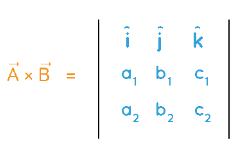

Another way to determine the cross product of two vectors A and B is to determine the product of the magnitudes of the two vectors and the sine of the angle between them.
Components of Vectors
A vector quantity has two characteristics, magnitude, and direction, such that both the quantities are compared while comparing two vector quantities of the same type. Any vector, in a two-dimensional coordinate system, can be broken into x-component, and y-component. In the figure given below, we can observe these components - x-component, Vx and y-component, Vy for a vector, v in coordinate plane.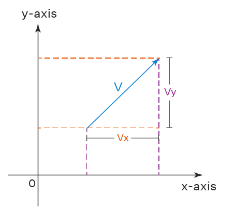
The values of Vx and Vy can be given as,
Vx = V·cosθ, and Vy = V.sinθ
|V| = √[Vx2 + Vy2]
 |
Download the notes
Chapter Notes: Vectors
|
Download as PDF |
Scalars and Vectors
Physical quantities that do not have any direction are called scalars. Scalars are nothing but real numbers, sometimes accompanied by unit measurements. On the other hand, vectors are physical quantities that have magnitudes as well as directions. Basic operations of addition, subtraction, and multiplication are applicable on both scalars and vectors.
Difference Between Scalars and Vectors
The only difference between scalars and vectors is that a scalar is a quantity that does not depend on direction whereas a vector is a physical quantity that has magnitude as well as direction. The common examples of scalars are distance, speed, time, etc. These are real values accompanied by their units of measurements. Common examples of vectors are displacement, velocity, acceleration, force, etc. which indicate the direction of the quantity and its magnitude.
Scalars and Vectors Examples:
- Scalar: Speed as 40 mph, Time as 4 hours which do not indicate any direction
- Vector: Displacement as -4 ft, velocity -40 mph indicate the direction. Negative velocity and displacement imply that the object is moving in the opposite direction.
Applications of Vectors
Vectors are very useful in the field of Physics and Mathematics. They are used to represent the position, displacement, velocity, and acceleration of objects and physical quantities. Some applications of vectors are,
- Vectors play a very crucial role in the study of partial differential equations and in differential geometry.
- Vectors are used in physics and engineering, especially in the areas including use of electromagnetic fields, gravitational fields, and fluid flow.
Solved Example
Example 1: Find the angle between the two vectors
 and
and 
Given two vectors a
We need to determine the angle between the vectors a and b using the formula cosθ = a.b / |a||b|
= (2 × 3) + (1 × -1) + (-3 × 1)
= 6 - 1 - 3
= 2
|a| = √(22 + 12 + (-3)2)
= √(4 + 1 + 9)
= √14
|b| = √(32 + (-1)2 + (1)2)
= √(9 + 1 + 1)
= √11
cosθ = 2 / (√14 × √11)
cosθ = 2 / 12.409
cosθ = 0.161
θ = cos-1(0.161)
θ = 80.73°
The angle between the two vectors is 80.73°.
Example 2: Find the sum of two vectors a  and b
and b 
Given two vectors
Therefore, the sum of two vectors is
Example 3: Find the cross product of two vectors  and
and  and verify it using cross product calculator?
and verify it using cross product calculator?
Given two vectors
Comparing these to the vector notations we have.
Applying cross product formula,
Therefore, the cross product of two vectors is

|
138 videos|67 docs|41 tests
|





